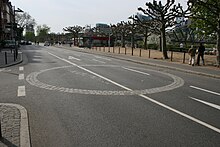Ulrichstein (Frankfurt am Main)
The Ulrichstein was part of the Frankfurt city fortifications . It is first mentioned in a document in 1391 in the list of gates and towers, so at that time it was already in the possession of the city as part of the Sachsenhausen city wall.
Probably the reigning Reichsschultheiß of Frankfurt am Main , Ulrich III. von Hanau , build the tower as a fortress or customs tower to protect his interests against the city. Occasionally, a building by Ulrich I. von Munzenberg (1217-1240) is suspected. The lead name Ulrich is common both to the Munzenbergers and to the lords and counts of Hanau who inherited them . After Frankfurt under Siegfried zum Paradies had replaced the liens on the Schultheißenamt in 1372 and thus became a Free Imperial City , the city acquired the Ulrichstein and incorporated it into the Sachsenhausen city wall.
There was a small gate in the city wall next to the Ulrichstein. It was initially called Fischerpforte or Mainzer Pforte . After the siege of 1552, it was expanded into a gate suitable for wagon traffic, which took on the role of the closed Oppenheim Gate . Since then it has been known as the Schaumainpforte or Schaumaintor .
In August 1635, the Ulrichstein was badly damaged when the Swedish troops who had occupied Frankfurt since 1632 withdrew. The ruin remained, however, even after the demolition of the Sachsenhausen city wall and the Schaumaintore in 1812. A new gate system consisting of two small classicist houses, a guard house and a customs house, as well as a wrought iron grille, has since controlled access to the city. When, after the Frankfurt guard storm of April 3, 1833, the Bundestag imposed the federal execution against the Free City of Frankfurt , the Prussian and Austrian troops from Mainz, who had been called to help, advanced through the Schaumaintor into the city on April 15.
The gates were locked at night until 1864. As the city expanded, the guard rooms lost their function. They were demolished at the end of the 19th century. Only the ruins of the Ulrichstein remained as a symbol of the Sachsenhausen bank and were restored in 1897.
In the 1920s, the Ulrichstein came into the sights of city planners, who planned the construction of a high quay and a flood-free road west of the bridge in front of the Dreikönigskirche after the construction of the old bridge . Although the city's magistrate and the Prussian state curator had spoken out in favor of preserving the ruins, the civil engineering department had the ruins demolished on March 10, 1930. An immediate construction stop ordered by Mayor Ludwig Landmann could not change anything. Today, a stone ring embedded in the pavement reminds of the former Ulrichstein.
literature
- Fried Lübbecke : The face of the city. According to Frankfurt's plans by Faber, Merian and Delkeskamp. 1552-1864 . Waldemar Kramer publishing house, Frankfurt am Main 1952
- Franz Rittweger, Carl Friedrich Fay: The old Frankfurt am Main , Michael Imhof Verlag, Petersberg 2006, ISBN 978-3-86568-118-8
- Hans-Otto Schembs , Walk through Frankfurt History , Verlag Waldemar Kramer, Frankfurt am Main 2002, ISBN 3-7829-0530-X
- Carl Wolff, Rudolf Jung: The architectural monuments of Frankfurt am Main - Volume 2, secular buildings . Self-published / Völcker, Frankfurt am Main 1898
Individual evidence
- ^ Ernst Julius Zimmermann : Hanau city and country. Hanau 1919. 3rd edition, ND 1978. p. 849.
Web links
- The Ulrichstein. altfrankfurt.com
Coordinates: 50 ° 6 ′ 26.3 ″ N , 8 ° 41 ′ 1.5 ″ E




